How a European bus company operates in Russia: how buses and passengers differ

82 centimeters between the seats.
The European company Lux Express takes passengers by bus from Moscow and St. Petersburg to Tallinn, Riga, Helsinki and the cities of Eastern Estonia (Narva, Sillamae, Johvi). I want to tell how their buses are arranged (they are built directly under them on the Scania chassis), how the business class differs from the usual one and about other infrastructure features. And at the same time go through how the driver lives on the road and what is needed to send the bus on the road.
In the meantime, we will focus on two features that show that we are still in Russia.
The first story is this: the buses have routers for eight SIM cards and four modems. They are connected in arrays for the Russian side and foreign respectively. Traffic is distributed over Wi-Fi to passengers and on tablet screens in front of each seat. Previously, the antennas were weak, about 10 meters, and a repeater was placed at the end of the bus. This caused several dangerous cases on the road, as the drivers of cars went almost right behind the bus, trying to use the free Wi-Fi. Now the signal reaches about 50 meters to the sides, and such situations are much less.
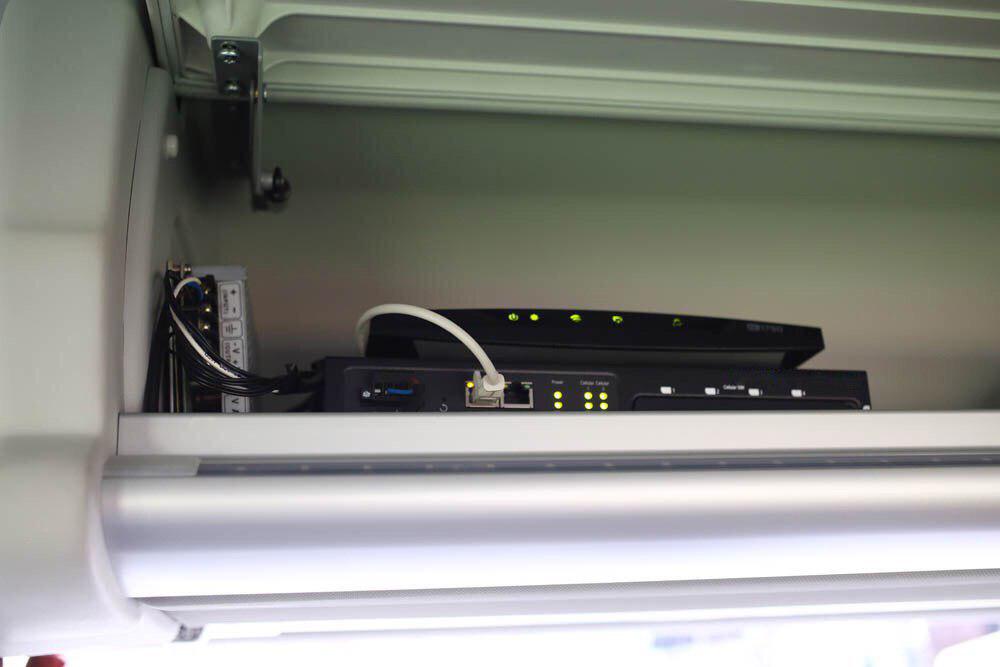
Thanks to this connection, you can even get a video stream from the bus registrar in real time: this is very convenient for the dispatcher.

The second feature is more prosaic. Recently, there have been frequent cases when passengers confused baggage and took someone else's. It turned out that this is due to the fact that a lot of identical bags are put in the luggage compartment of the bus. And there were a lot of them, because supermarkets began to organize promotions to collect sticker chips at a discount on these same bags. Everyone buys products, and so many travel with the same bags.
But work in Russia differs not only in such stories. Let's start by explaining who generally rides buses between cities when there are trains and planes. The entire Lux Express group of companies operates on routes that are commercially attractive. These are high-speed lines between large cities, when a bus is often more convenient than other modes of transport.
Here is the comparison:
- Bus versus train: the journey time is the same, but buses from St. Petersburg to Riga, Tallinn and Helsinki run more often, that is, you can choose a more convenient time. There is nothing to do on the train for all six hours, and on the bus in front of each passenger there is a screen with a database of films in different languages, and you can watch them while you are traveling.
- Bus versus airplane: many are still afraid to fly, time differs by an hour (taking into account the need to get to the airport, registration and road to the city on the spot), the bus is cheaper.
- The bus is against its own car: there is less queue at the border, because ordinary cars stand in line (sometimes for many hours), and passenger buses go along the priority corridor for regular carriers and ride on toll roads in cities and at the border, and travel along lane A in the capitals, which greatly reduces the time to get into the city. By car, it is cheaper to travel only to a few passengers at once.
For many years, the company has been analyzing people’s flows for 300-500 kilometers (most often it’s business, tourism, study and medicine) and organizes a route there at the price of a low-cost airline. Sometimes, intermediate stops are important for passengers: for example, on a flight from St. Petersburg to Riga there is a stop in Tartu, a city with a population of 90 thousand inhabitants, where nine trains leave from Tallinn every day and 33 departures per day (35 - on weekends) Lux Express. Another interesting route is from St. Petersburg to Helsinki-Vantaa Airport, from where you can fly with a low-cost airline. Well, the airport is developing rapidly, the number of flights there is good. The bus gives a direct flight at a convenient time, and you can pretty cheaply make a site, then to transfer to Wizz, Ryanair or another company with ticket sales.
Now the main customers of the buses are those who used to drive the same directions in their cars. They tried that you can go much faster, more relaxed and at the same time not to suffer on the road. Since the carrier is still European, our original Russian tradition of suffering everywhere is not in their cultural code. There was a survey on the Petersburg-Helsinki flight, here are the results (several options could be chosen): 45% of passengers want to spend a weekend or vacation in the city, 38% go to the airport, 30% want to continue the trip in another way, 21% want to buy something , approximately 20% of bus passengers are business travelers. There is still a strong tradition in St. Petersburg where you can compensate for part of the cost of the trip by helping to drag cigarettes or alcohol across the border: transporting them for personal use is cheaper than paying a fee, and this scheme was used in large quantities. So far, Finland has not introduced a restriction: you drive less than 72 hours - you can’t carry alcohol.
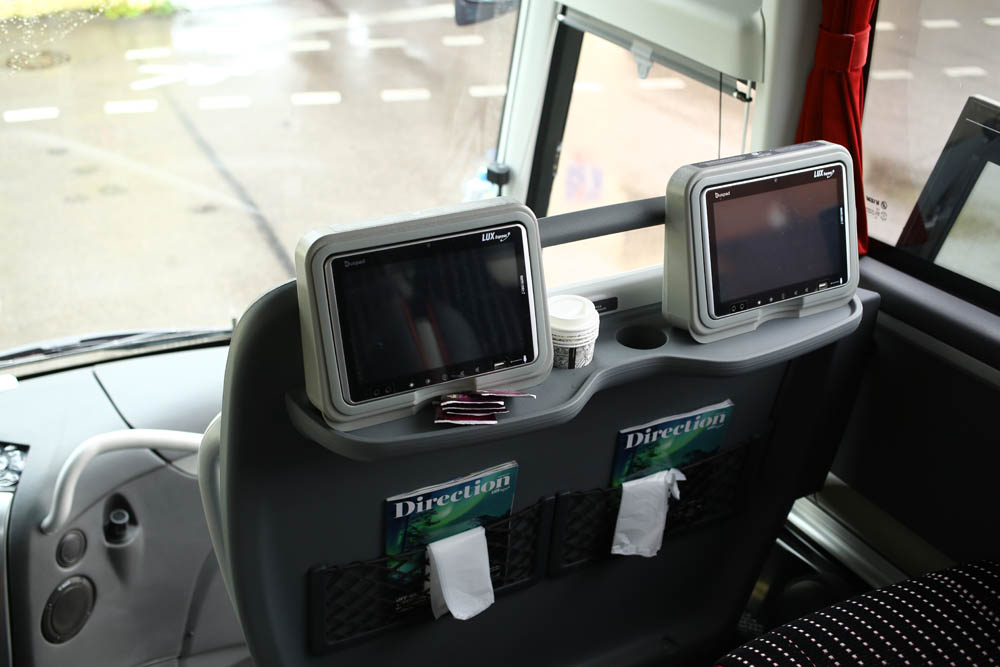
How do the buses differ from the usual for us in the Russian Federation?
It’s not very clear what to compare with, but I’ll just show you things that are not always around the country.
The interior is almost ordinary:
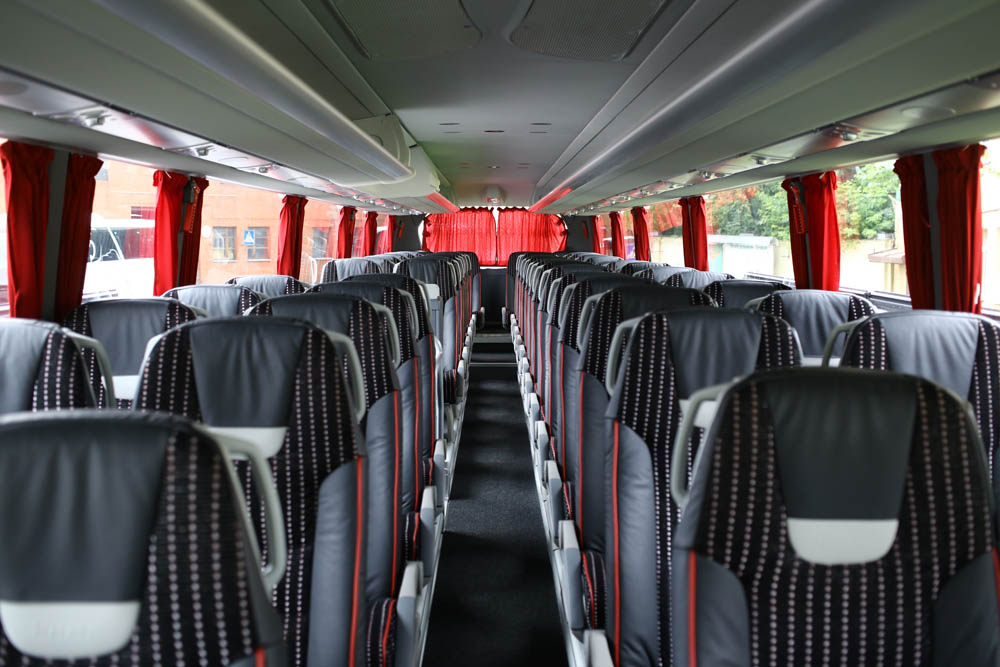
But then the fun begins. In the back of each chair is a tablet with films:

Browser:
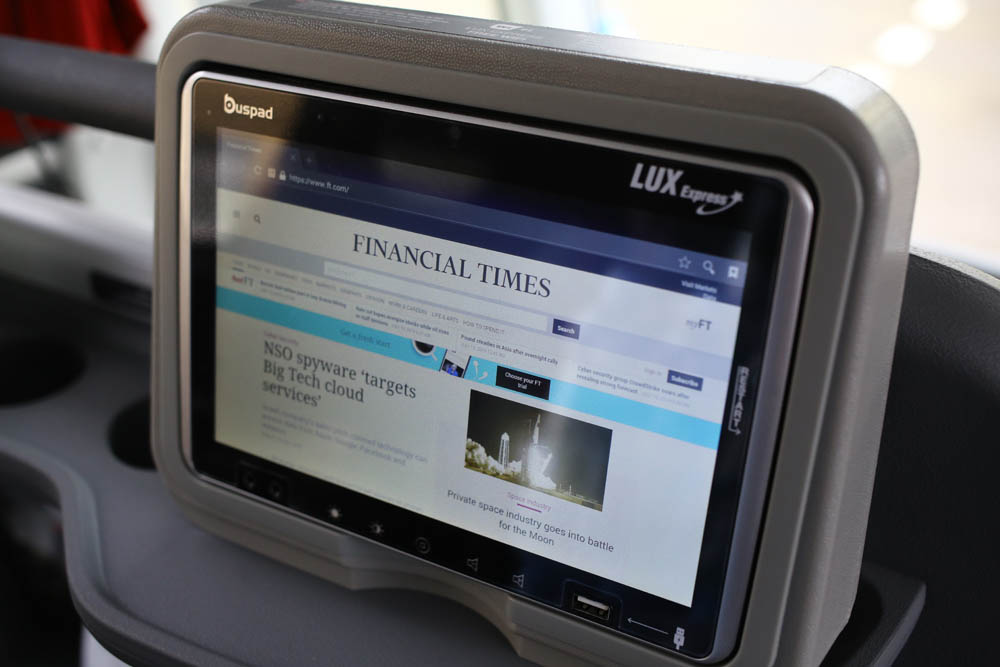
Audiobooks:

And a USB port so that you can charge your phone or your tablet:
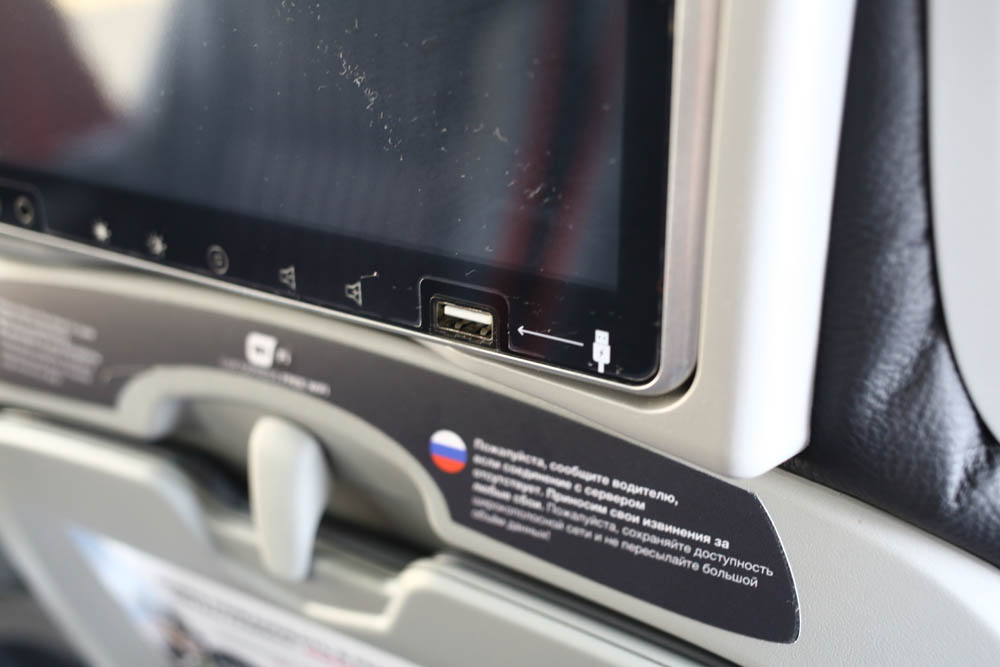
There is also a section with games - a real salvation for traveling with children.
In case you want to boil tea, there is a ground outlet. In fact, of course, it is for charging other devices like a laptop, and you cannot use a boiler or kettle. Boiling water can be taken in the coffee machine. And the grounding in the bus is not arranged in the same way as "on the ground" or in a train where there are rails. Sockets are in a separate enclosed electrical system. 220 Volts comes from an inverter that is powered by a 24 Volt bus network. If a leak occurs, the subsystem shuts down automatically.

And tea can be taken in the coffee machine. Just a bag of on-board set with boiling water or just one type of coffee. There is a station right in the center of the cabin:
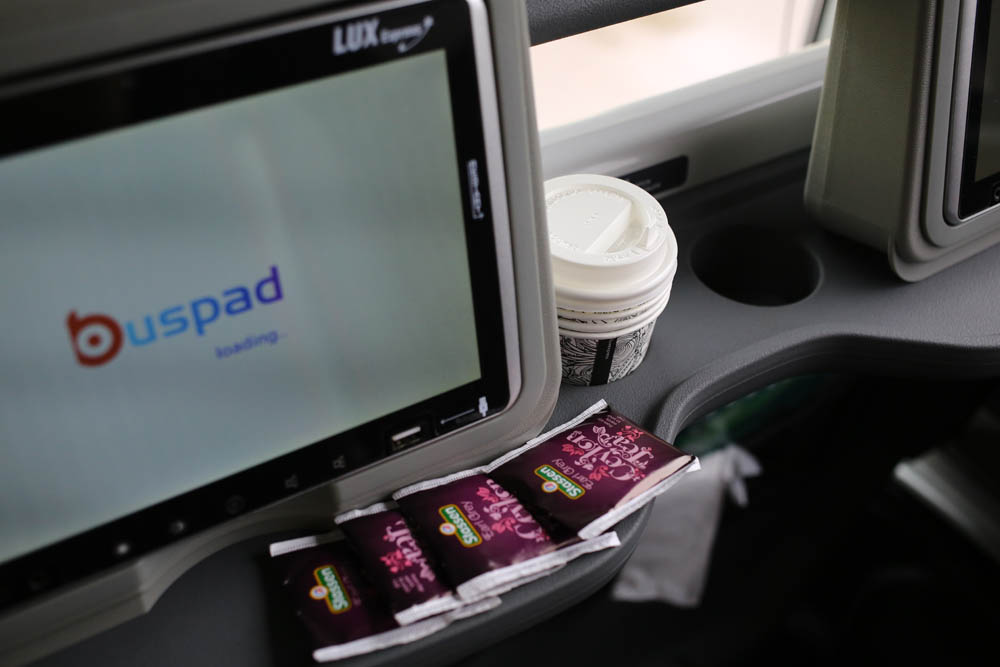


There is also cold water. Here, by the way, she is going for a U-turn flight in the luggage compartment:

Luggage compartment itself - standard:

Nearby there is a resting place for the driver:

In this nook, the second driver can rest while parked. From there, you can call directly to the driver's seat: on the side of the one who is currently driving, there is a telephone:

Here is the driver’s workplace:

His seat is almost the same as that of the passenger, and is almost as adjustable. The difference in the air bag is that when driving relieves the load on the spine. In the passenger compartment, you can move the seats back and forth and left and right. Here is the usual situation:
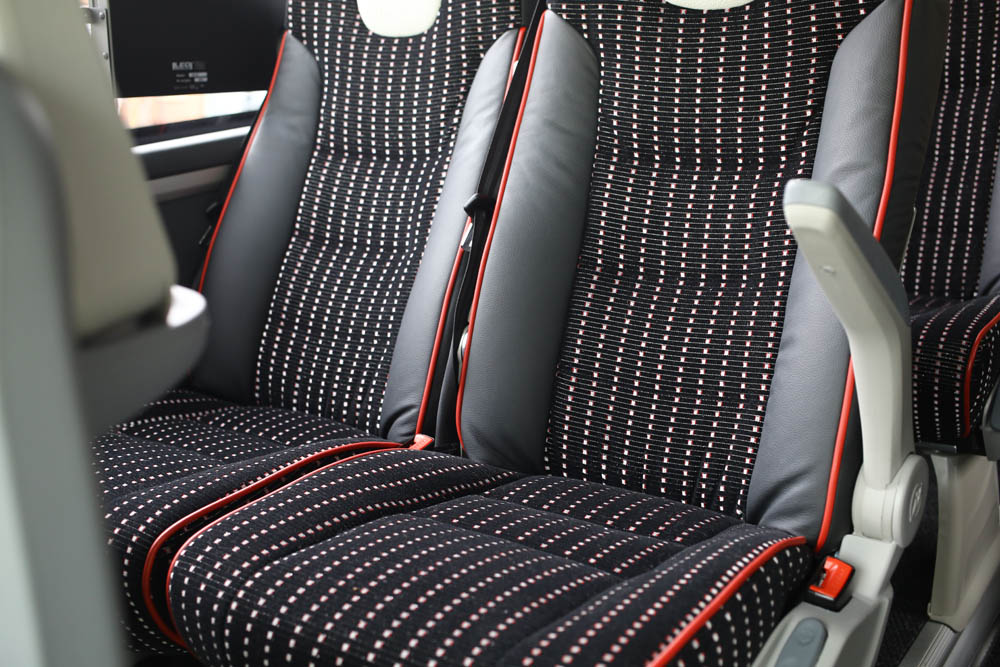
And so you can start moving towards the aisle:
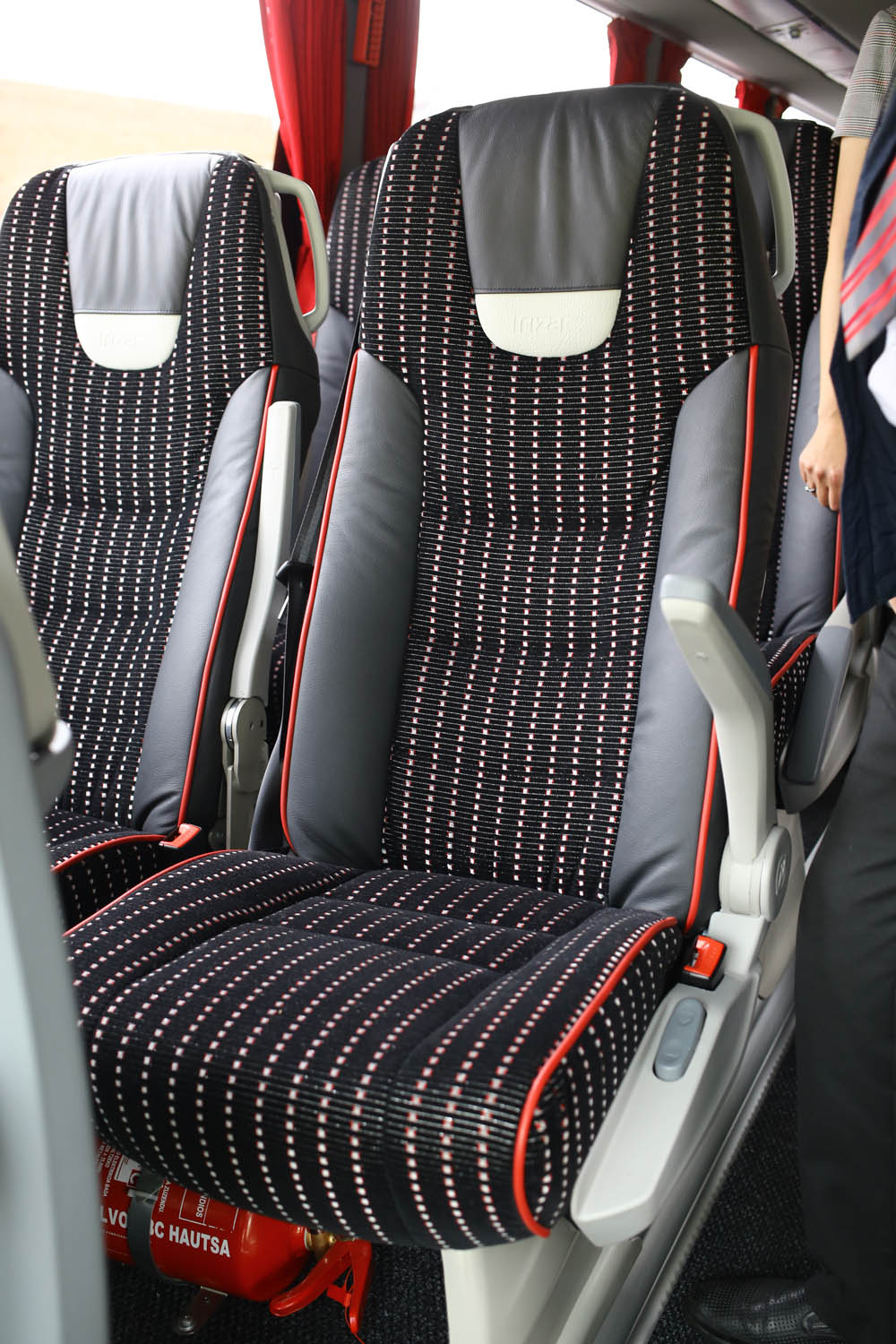
In the middle of the cabin there is a toilet that works all the time:
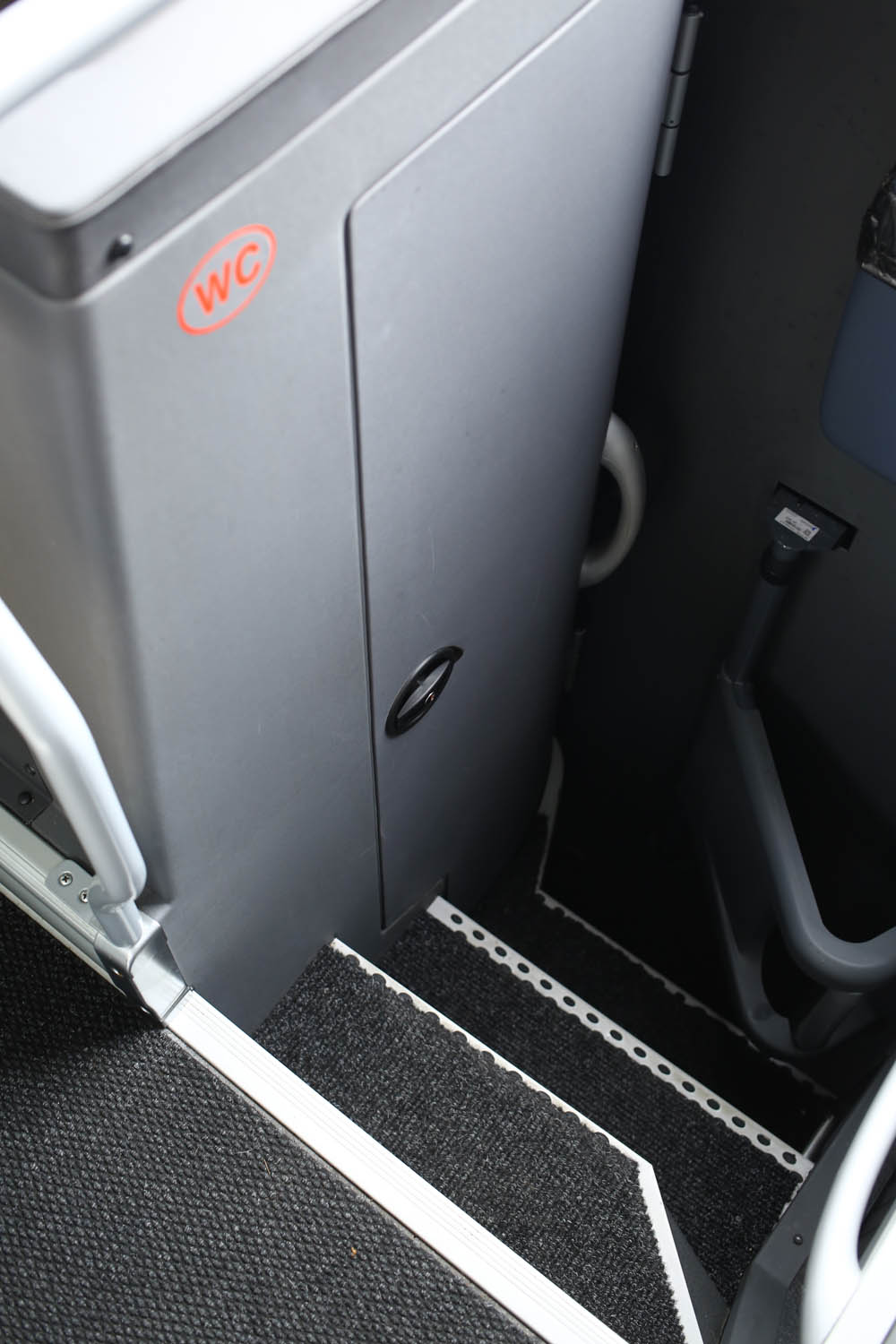

Buttons at the top, as in an airplane:
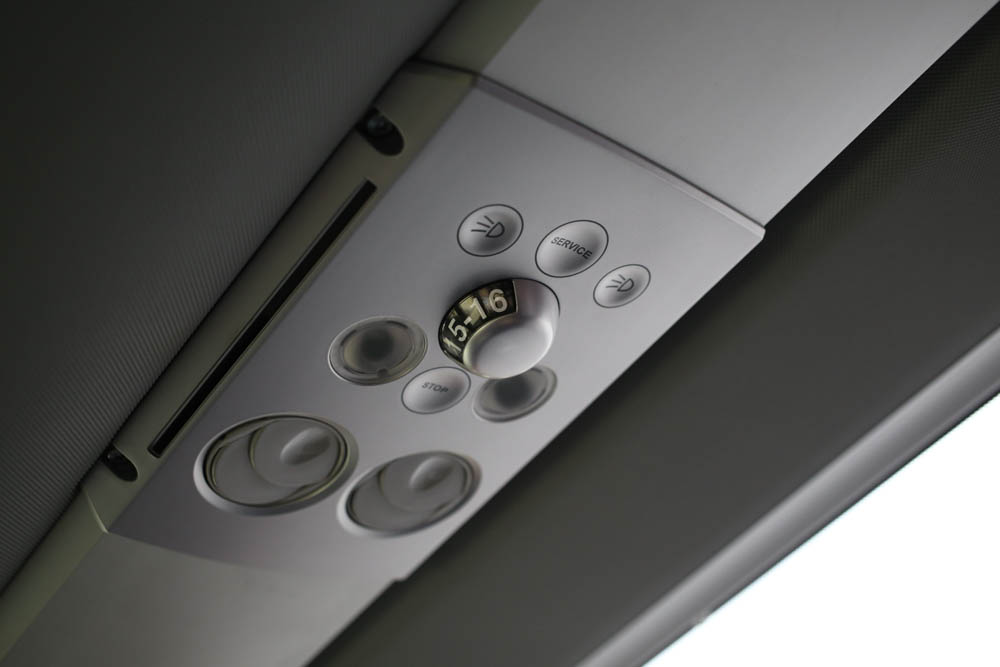
The doors to the bus are illuminated from below (steps are highlighted according to the standard) and from above - this is not necessary, but these buses have LED sources that illuminate a large area near the bus: it is convenient for working with luggage at night.

And what is the difference between transportation in Europe and ours?
In general, our market is striving for the European one, but there are still a lot of “gray” transportations, that is, without permissions and compliance with standards. Here we talked in more detail about this situation a year ago, and everything described is relevant today.
Gray carriers interfere with the market by:
- They do not provide minimum passenger comfort, since they operate on the principle of reducing their own costs. This is not about toilets and coffee, as it might seem, but about the fact that the bus is not a convertible with a rusty roof, and that the driver cannot just pick up and throw the passenger out. And about the fact that you can not stop in the field and turn around. Or cancel flights without compensation.
- They do not conduct proper vehicle inspection before entering the route - this increases the risks, but there weren’t any high-profile accidents. I repeat: it is loud.
- Do not conduct a medical examination of the driver before the flight - accordingly, anyone in any condition may be behind the wheel. But he will take it. Probably.
- Do not insure passengers (this is mandatory for official transportation).
- Do not serve routes and do not sell electronic tickets - this already hinders the infrastructure, because now there is no single schedule and single point of purchase of tickets, both on Russian Railways and in aviation.
- They repair the vehicle as it goes: “white” companies work most often through official services certified by the chassis and bus manufacturers.
In Europe, the market is much more centralized than ours. If we have thousands of small carriers, then there are either large companies or alliances, which eventually gather in hubs and have the ability to set up a common IT exchange. If on railways all IT goes outside through Russian Railways (the owner of the infrastructure and most of the rolling stock), in aviation through airline associations, then everything is very fragmented on buses. But the market in Europe has already grown to the stage of large associations and, in particular, precisely because of the desire of people to see the general schedule and buy tickets from home. Competition with trains makes itself felt.
In Europe, there are almost no unofficial traffic. Carriers have customer support, for example, Lux Express - call centers in Riga, Tallinn, St. Petersburg and Vilnius, which answer 24 hours a day in six languages (Russian is one of the basic). Any changes that become known in advance (such as a shift of departure by 15 minutes forward) are sent via SMS, email or phone calls, whichever is more convenient for the client. When the driver reports a problem, he says this right to the passengers and to the contact center. In the contact center they see who is going and where, who has what kind of connections, connections, and right away they begin to pick up alternatives. In general, this is how it should work if you carry people for many years, care about your reputation and understand that the legal system works so well that in case of any problem a citizen can begin to understand through the courts. And this is normal.
It’s still easier for us to come to the bus station than to look for buses in 40 search results. Yes, we do a single schedule for Russia ( this is the story ), but there are a lot of recovered data, hypotheses, and still have to photograph pieces of paper at the bus stops to understand what goes in fact and when. Nevertheless, we have already covered most of the buses.
But at the same time, our situation is already better than in some countries of the former USSR.
Another important difference between Europe and Russia is the location of the bus station. As a rule, he is alone in the city, he is large, he is equipped with everything that large railway stations are equipped with, and is located in the city center almost on the main square or near the main shopping center. At the same time, it has historically happened that most of the railway lines come to the outskirts of cities, so buses are often more convenient in this regard.
What does a driver's working day look like?
Driver Eugene gets up at 6:00 in the morning and drives to the base at 8:00.
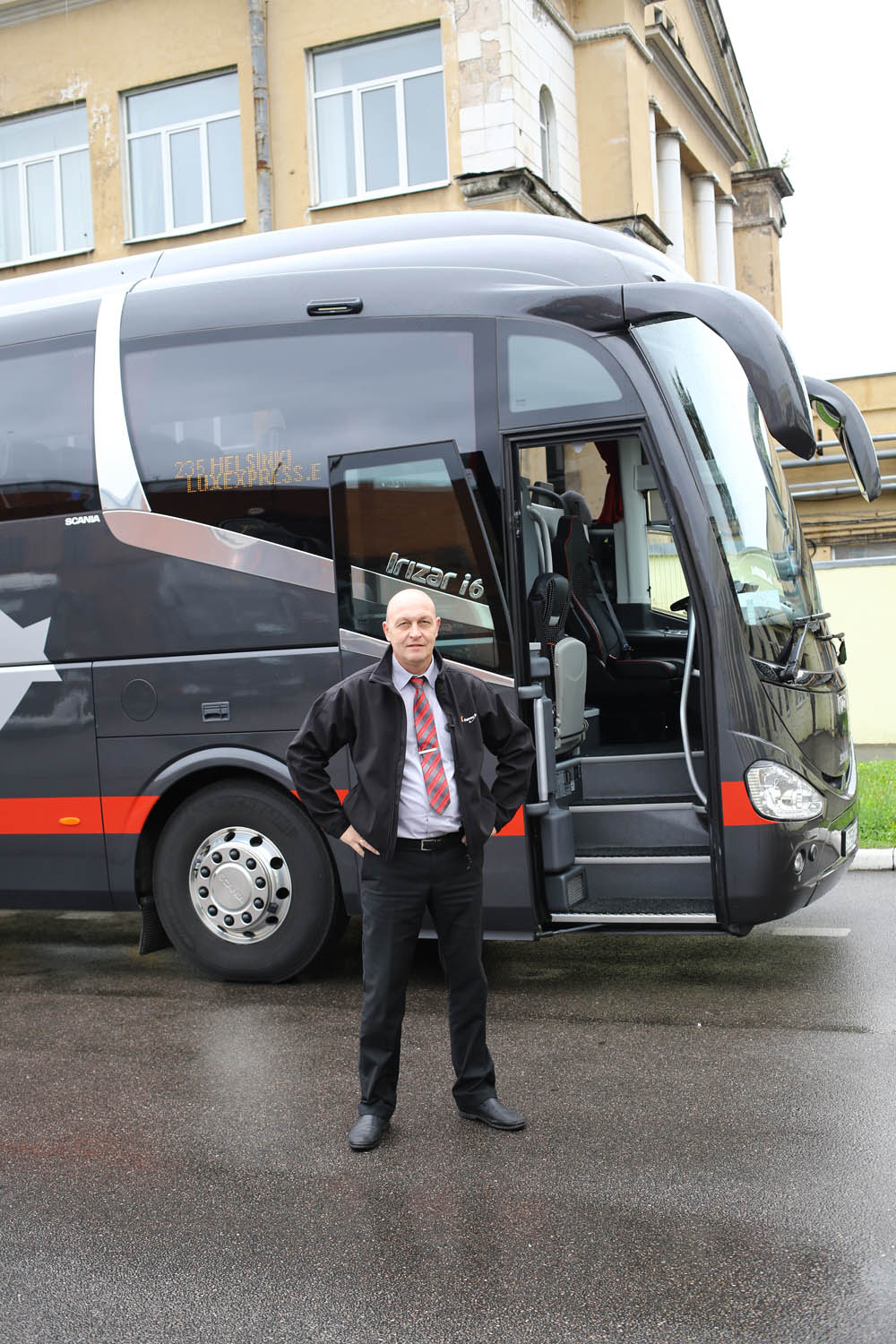

In St. Petersburg, it looks like this, and not only buses of this carrier are serviced there: it is a convenient unit for storage between flights, that is, there is also a first-aid post (for inspection), office rooms of company dispatchers, a kitchen, a washing machine and a dryer (they are erased bus cleaner clothes, curtains), spare parts warehouse, cleaning warehouse.
Since the schedule for drivers is quite complicated, it is often convenient for them to eat and do different household things right at the base.
The driver must be at the base an hour and a half before leaving the park. The first thing that Eugene does is go to the doctor. At a physical examination, pressure, temperature are checked; the paramedic carefully checks Eugene for alcohol, checks how he moves. Then puts a mark in the waybill. If something happens due to the driver’s fault, people will suffer and it will become known that he could not be allowed on the flight for medical reasons, then the doctor will sit down. That is the responsibility.
Further, the driver has the right to drive.
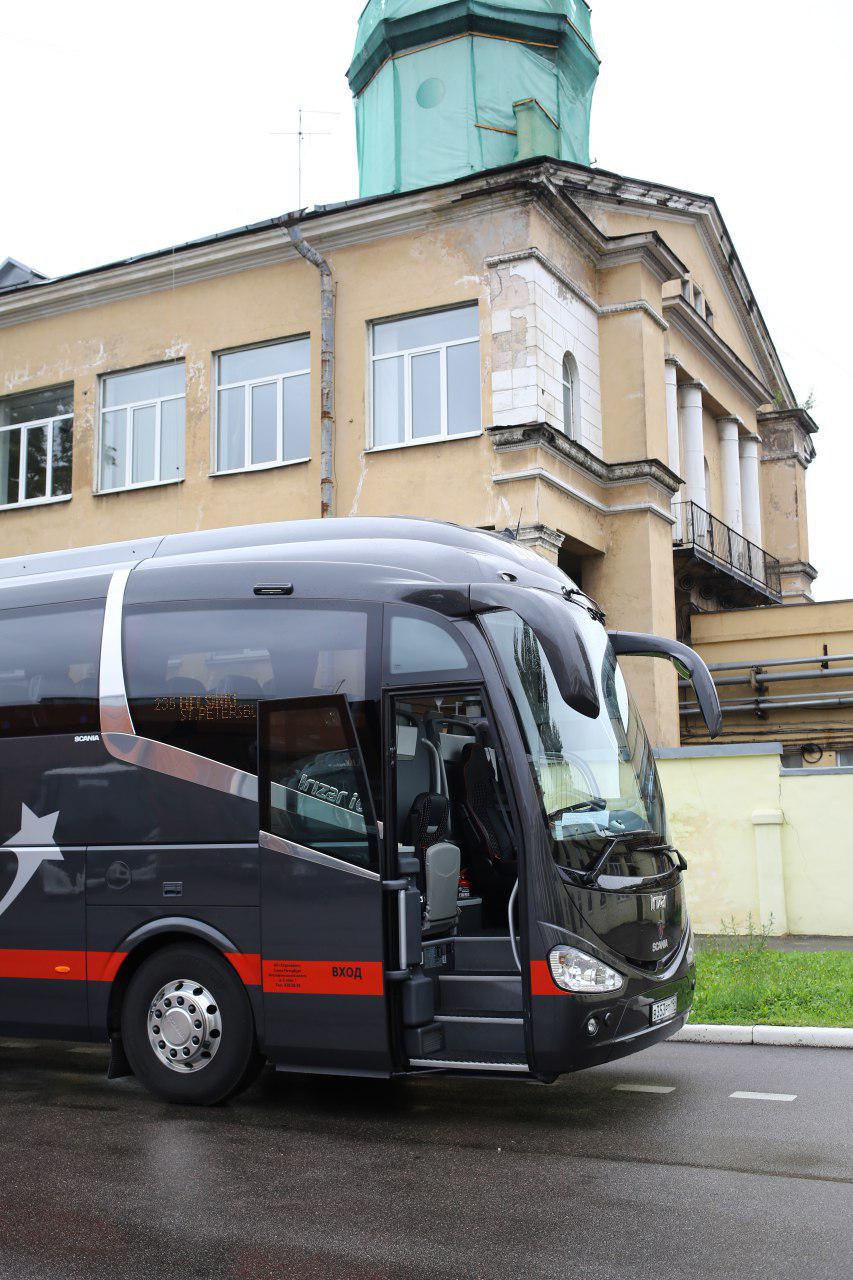
Eugene drives the bus to the mechanic. He examines him and gives the go-ahead for the release. This is not a routine maintenance, namely inspection before departure. Regulations are made regularly.
Meets the second driver.
Then Eugene checks the consumables and loads them, if necessary.

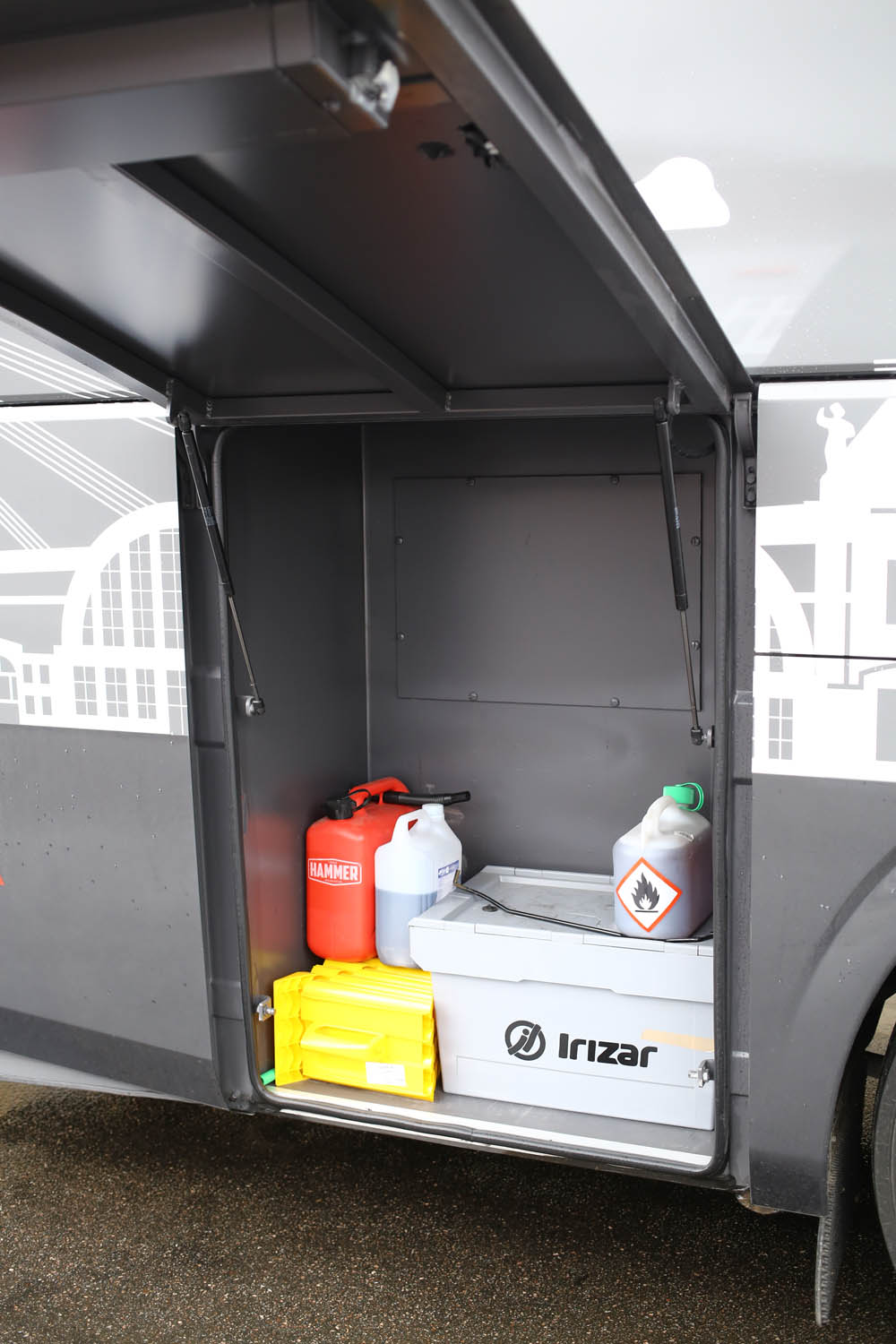
Consumables are tea, coffee, magazines, headphones, water, snacks and everything else that is needed on a round-trip flight.
It adjusts the chair for itself, includes all subsystems (tablets, the Internet, climate control).
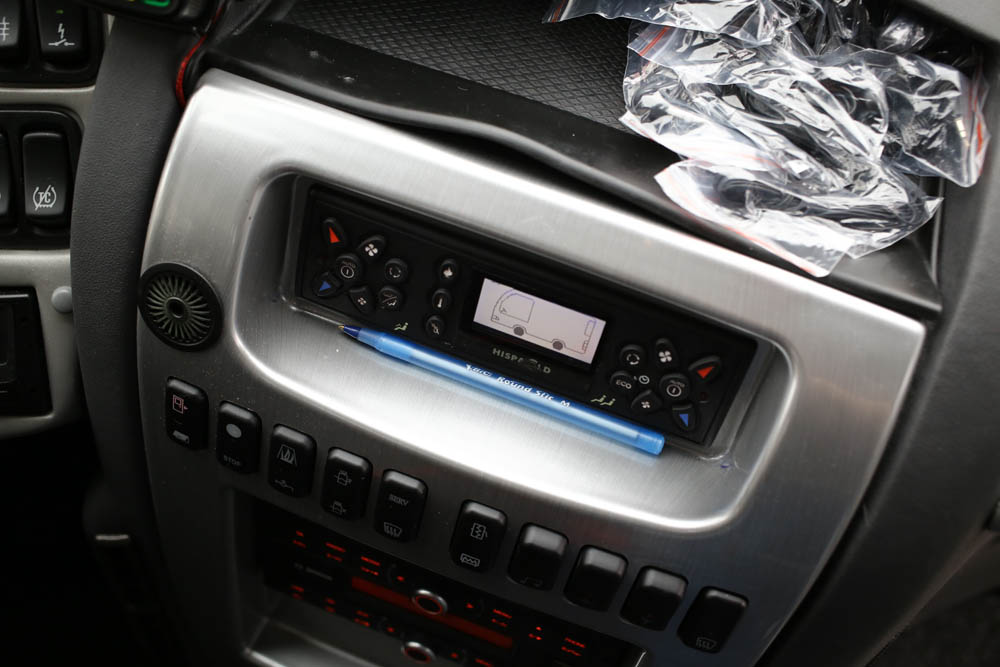
Goes to the bus station. All departures begin with him. He gets up at the designated place and waits for passengers. Together with the second driver he helps with luggage, with tickets, with seating.

He is convinced that everything is fine, and the bus leaves on schedule.
Then Eugene drives the bus, and the second driver is resting. In fact, for the first 15 minutes, the second driver works as an enikem, because passengers on European lines are quite conservative and do not always understand how and what can be done with the tablet. There was a case when a grandmother from Tallinn asked me to turn on comedy because she herself could not. They turned it on. Then she asked for another movie. And after switching five films 5-10 minutes after they started, she complained that it was difficult for her to read subtitles: her eyes were no longer the same. It turns out that she did not even imagine that it was possible to use headphones: it simply didn’t fit in the head of an elderly person, that you could listen to something on the bus. Then she watched the movie in its entirety, and then thanked the driver very much.
Departure from the city by toll road and lanes for passenger vehicles, then an important milestone - the border. There is a "green corridor", a fast passage. Arrival in the city of arrival is also in priority lanes.
On the spot, you need to inspect the bus again, tidy up, put out consumables, see the condition of the tablets in monitoring and physically prepare for the flight at the bus station again. There is a time of sludge: the driver can not look at the road for more than 4.5 hours in a row, so you need to either change or switch to something else. Some carriers make special stops at this.
Then everything is in the opposite order - to St. Petersburg, but usually the second driver begins to drive, and Eugene helps passengers.
On the spot - disembarkation of passengers, assistance with luggage. Next - to the base.
If there are lost things - inventory.
Inspections are underway again, because you need to close the waybill: mechanic, medic. They put the bus in the parking lot. They compile a list of service requests in the company's IT system: they can indicate that somewhere the lamp has burned out, somewhere something needs to be replaced. By the next flight, the mechanic will correct everything.
What happens if the driver gets sick?
So that the driver can go on a flight, you need to do a lot of work before that. For many months, justify the need for a route and get it, that is, draw up a schedule grid. Then fill this grid so that drivers, repaired buses and all consumables (which need to be purchased) converge in one place. This is done by the dispatcher. The task of the planning manager is to make a schedule of drivers, documents, insurance, fuel cards and entrances to stations.
Each country has a so-called traffic manager. This is the technical coordinator who is at each base, he is responsible for ensuring that the buses can leave: he buys everything he needs, gives instructions to the mechanics what and in what order to repair, provides a “back-up” for those who are sick, and so on. The Russian base has 14 buses and about 70 employees (65% of employees in the group of companies are drivers).
And there is the same specialist for clients: he connects at the stage of ticket sales and during any unforeseen situations like a bus delay (nevertheless, it is not a plane or a train and depends on the load of the road and checks at the border of foreign passengers, which may have a long check documents). The client dispatcher also communicates with other carriers if you need to find a replacement for the bus or pick up a passenger.
Only the driver communicates with the traffic dispatcher, and any passenger can contact the service dispatcher. As well as the dispatcher can send instructions to any passenger on what to do: this is the debugged part of IT when conditional roles are configured, and then one instruction is sent to passengers with a transfer via SMS, and the other is sent to others.
If the bus is late, then the dispatcher knows this before you, and if you have a transfer, he is already looking for an option. Here they are, the benefits of official carriers. If you are late for more than 15 minutes, data is given to those who meet (if the passenger indicated them), a taxi is booked just in case (more precisely, it is reserved, this is a slightly different procedure).
The routes are fixed, but additional volume is added seasonally. The fifth flight for the summer instead of four, additional flights for Christmas, for Russia - additional flights for May and November weekends. At this moment, the entire park is put up for routes, the rest of the time there are backup buses.
Tickets are put up for sale for six months. At our place in Tutu, they appear the very second when they are available on the carrier’s website and at the bus station.
FAQ
- How do business places differ from ordinary ones?
The standard layout of buses is 2 + 2 (two seats on each side), and in some the first 30 seats are ordinary, and then 15 is a business. Layouts are found 2 + 1 and 1 + 1. The distance for the legs is another six to eight centimeters longer than in the usual layout (90 centimeters versus 82). The chair itself is somewhat wider. The passenger receives snacks (there are no pastries on board, so just snacks - chocolate and so on). More privacy, that is, you can work calmly without fear of looking over your shoulder. Everything else is like everywhere else on the bus.
- The development of trains reduces the share of buses?
Bus passengers are most often a fairly regular audience, which after the first trips suddenly begins to love this type of transport. Many said that the launch of Allegro (this is a high-speed train Petersburg - Helsinki) will not allow business to develop, but buses have shown that they can take part of the train flow.
- What kind of sites are blocked on the bus server?
Two lists of sites provided by an external provider are blocked by DNS:
- Porn sites and all 18+.
- Potentially dangerous sites (phishing, virus distribution, etc.).
That is, it looks like the included antivirus with parental control.
Blocking 18+ is due to the fact that watching porn in a nearby place does not allow children to avoid watching this nearby, which does not always comply with the legislation of European countries.
There is no traffic limit, a few years ago it was 300 MB per passenger. Now they have solved the problem by the fact that the file transfer is limited in speed so that one of the passengers does not monopolize the traffic. The video from YouTube is shown normally in 720p quality (usually most of the passengers watch movies from the local media server). Movies on the server are updated automatically when the bus arrives at the station lighthouse: there is the response part of the system, which takes the logs of the bus subsystems and gives updates through the air.
Previously, drivers knew the characteristic “pits” of Internet coverage along the road (now they are no longer there). As soon as complaints came, there was one driver who clicked some healthy button beside him and said: everything will be right now. You can turn it on and off if it doesn’t work. And after 30 seconds everything works.
- What is the difference between the chassis and the bus itself?
The chassis is the chassis and frame. Everything else is going to the Lux Express project to unify buses throughout the network. Among other things, a leather steering wheel, half-leather seats, SCS for 220 V sockets, a camera on the central door, a rear view camera, heated seats and a windshield, braking sensors, deviation sensors from the strip are placed. The current manufacturer of the chassis is Scania, but you can do it on other vendors. In Russia, Euro-5 engines, in Europe - Euro-6, there is a 12-speed gearbox, 450 l / s engine. In the combined cycle, the bus “eats” 26–27 liters of diesel per 100 kilometers. In the future, liquid gas chassis, a hybrid with electricity, and electric buses are expected. New developments are still more expensive than usual, there is no full adaptation of the body to the chassis. Well, we need infrastructure.
- What kind of strip control sensors?
This is a limited autopilot that can check how much the bus is in the lane. They are part of driver assistance and part of a security system that gently stops the bus if the driver does not show signs of life.
- At what speed does the bus ride?
The hardware limitation of the bus at the on-board computer firmware level is 99 kilometers per hour. Usually allowed to drive on general roads at speeds up to 90 kilometers per hour, but there are sections where buses can accelerate to 100, this is indicated by special signs.
All movement of the bus is fixed by the “black box” - the tachograph. This is necessary to control the route, verify the time of departure from stops and so on. Modern tachographs are not just mechanical recorders, but devices with GPS navigation, they include the telemetry of the bus sensors and all the data of the flight systems, in the case of these specific buses they still have remote access and the ability to broadcast everything in real time to the dispatcher.
But! Moreover, sometimes they write in support: "Your winged bus has overtaken me." The answer is interesting. The fact is that bus speedometers are different from civil car speedometers. Just because of the connection with the tachograph, they are calibrated much more accurately. In a passenger car, the feature is that the tolerance is quite wide, but at the same time, the speedometer should not show a speed less than the actual one. And it doesn’t matter what rubber is worth: the user can deliver even more, which adds two to three kilometers per hour. Therefore, at speeds of about 100 kilometers per hour, in fact the difference is from 5 to 10% down, that is, nine to ten kilometers per hour. Bus admission is plus or minus a kilometer. Hence the overtaking.
- Is it true that “our” passengers are less high-moral than in Europe?
No, it all depends on specific people. The level of garbage and the number of conflicts are approximately the same throughout Europe. Previously, there were complaints about animals on the bus, and how to solve them was not clear.Now they simply closed the transportation of animals without special approval throughout the Lux Express group (except for individual flights within Estonia) (we are not talking about guide dogs).
Smoking in the toilet is quite rare, but when this happens, the monitoring of the bus thinks that the bus is on, offers the driver braking, and if he does not respond, he performs the stop and evacuation procedure himself.
- How to carry a bicycle and a lot of luggage?
According to official rules, you need to come and see if there is a place in the luggage compartment. If there is - you can take in excess of the norm. In practice, it’s better to warn the dispatcher: if you arrive in 20 minutes, you can pack more conveniently because it’s better to pack large things first. The dispatcher can change the ticket for the next flight if it does not fit in. Upon luggage failures - units. Once a woman transported a closet from Estonia, and then decided to take a second one, and here they didn’t allow her.
- What happens to lost things?
If they show up at the station and it is clear whose thing this is, the dispatcher contacts the client. If it is detected later or if a person could not be found, then they are described and are waiting for the passenger. European service involves its active search and advanced compensation.
Most often, laptops and phones leave, a little less often - charging and passports. People can easily forget the crutch. The worst “loss” was this: the European grandfather ordered a false jaw, two months waiting for her from the clinic in Tartu. And so, 14% of the total number of forgotten things in 2018 is occupied by passports, the second place - hats and other hats: 12%, the third - scarves: 10%.
You can also lose the passenger. Then the luggage will reach, and the passenger will need to pick it up at the regional office. On the Riga – Tallinn route, most often on the intermediate in Pärnu, these are places where passengers always disappear. They leave for a smoke, do not return on time - and the bus leaves. But they often catch up with a taxi. When “chasing” it must be borne in mind that the bus can only stop at stops, so the process can be delayed.
Andrey Skimborsky, technical director of Lux Express Group, was with us:
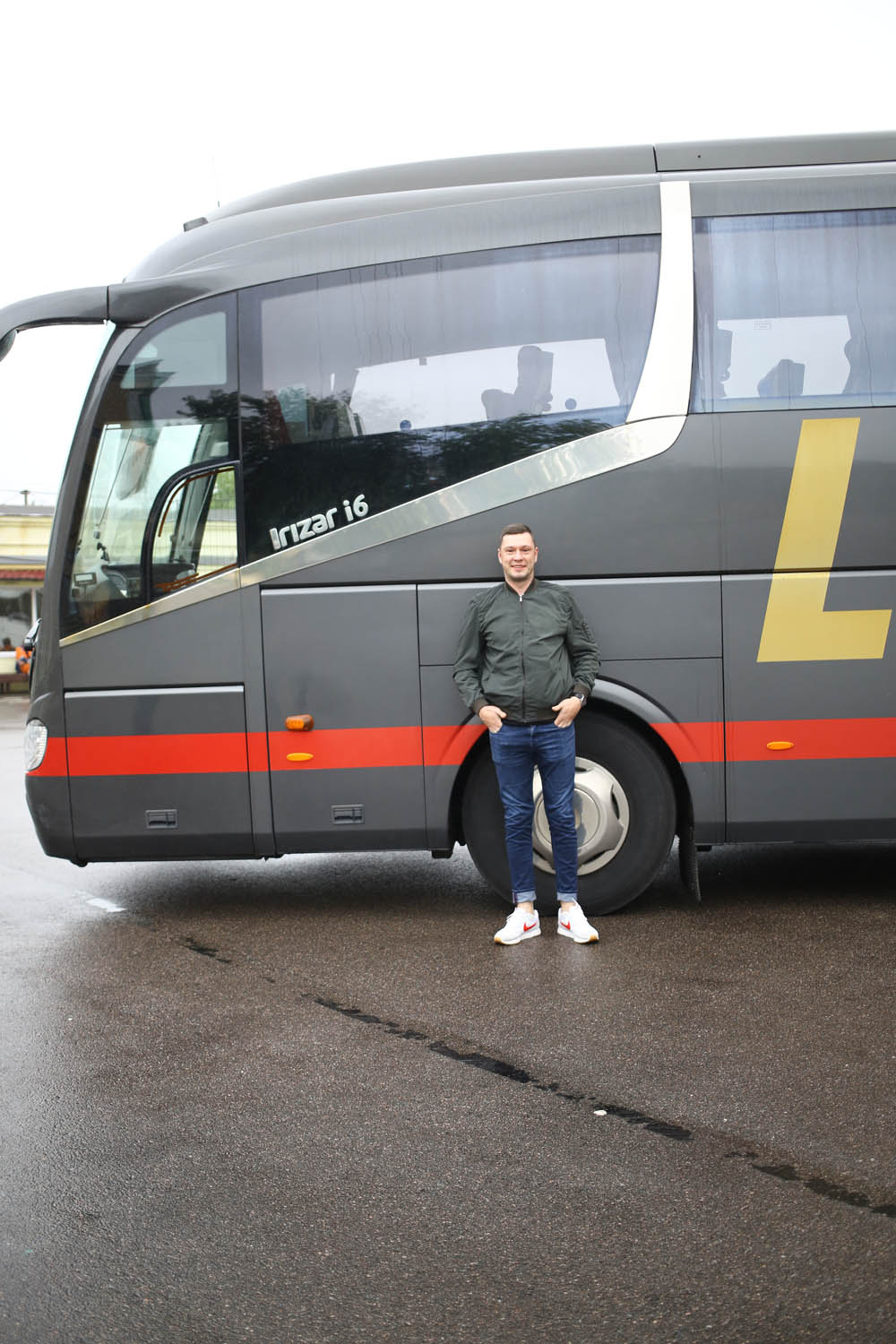
And Tatyana Korshunova, Deputy General Director for Operations of the Russian division of Lux Express:

If you have questions for specialists or for us, ask in the comments. In the meantime, here are links to our other posts about buses in Russia: how the intercity and suburban buses are arranged in our country , how we restored the schedule of intercity buses , FAQ on intercity passenger bus flights .
All Articles